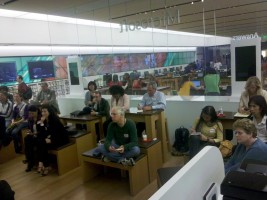@ModernJourno Tweets for Apr. 6
- Center for Public Integrity to Start New Site for Investigative Journalism http://nyti.ms/eV4p7A (by @tanzinavega / @mediadecodernyt) »
- How to properly credit a tweet http://bit.ly/h0l3V9 (by @QuantumGood / @TweetSmarter) »
- "We are transitioning into a true multimedia corporation by 2012" –Emmanuel Hoog, CEO of Agence France-Presse http://on.wsj.com/fmV85T »
- Online communities need leadership: Will journalists provide it, or will someone else? http://bit.ly/fgPYPM (by @robertniles / @OJR) »
@ModernJourno Tweets for Apr. 1
- Try using these 5 tiers to measure the value of your news coverage http://bit.ly/dGBtC3 (via @suzannemarmion) #pubmedia #wjchat #spjchat »
- ‘Never’ Use Twitter as a News Source? Let’s Talk http://bit.ly/e0J8WJ (@WendyFry / @ModernJourno) »
- 5 Teachable Lessons From the Washington Post's Mistake http://to.pbs.org/hABzCW (@NathanGibbs / @PBSMediaShift) »
‘Never’ Use Twitter as a News Source? Let’s Talk
This post was originally published on Wendy Fry’s Posterous blog, April 1, 2011.
I was in a collision this morning. A traffic accident of sorts between new media and old.
Somewhere between a jog on the beach, yet another redevelopment debate, FPPC complaints and hotel construction to cover, my two-years out of journalism school and fiercely protected new media mindset crashed full force into Stewart Jacoby, the director of radio programming for South Texas Public Broadcasting System, Inc., a broadcast journalist for the past 40 years.
It all began on Twitter, of course, with a tweet by Grant Barrett of voiceofsandiego.org:
“WHAT?!” I cried. Jacoby and I needed to have a conversation pronto so I could enlighten him on the ways of our brave new world.
@ModernJourno Tweets for Mar. 31
- Some great examples of teachers using social media in the classroom http://wapo.st/fRHgGR (via @christinasmag) »
- Professors With Personal Tweets Get High Credibility Marks http://bit.ly/ihXH9L (@benbwieder / @Chronicle) »
3 Mac Tips for More Efficient Workflow
Many newsrooms are switching to Macs as they replace old equipment and put more focus on digital. While a Mac isn’t necessarily superior to a PC, it can simplify your computing.
Here are three quick tips that will help you get the most from your MacBook, MacBook Pro or iMac.
Spotlight
Does your desktop look like this?

If it does, then that’s just unacceptable. One of the best features on a Mac is the ability to search the entire computer, and to do so quickly and easily. Start the cleanup by familiarizing yourself with Spotlight. Press Command + Spacebar and you’ll see that the top right corner opens to a search field. (You can also just click on the magnifying glass, but the sooner you get started with keyboard shortcuts, the better.)
@ModernJourno Tweets for Mar. 25
- FREELANCE: List of outlets with links to their submission guidelines http://bit.ly/f0MEX6 via @MeridianStories #writing #photography »
- How blogs have changed journalism: http://reut.rs/h5nvtU by @felixsalmon »
- Behind the scenes of @OHnewsroom with @ohmykevin: http://bit.ly/hBQMd6 by @webjournalist »
- "In today's digital world, journalists must not only create the stories but make sure they get to readers." http://lat.ms/fiAjZ3 »
- "@Lavrusik: Useful tool: TweetWhen shows you when you are most retweetable (time & day)" http://bit.ly/eCa9fo »
- Social Media Is About Failure and Forgiveness http://bit.ly/dY6RFs @LilyShumLeung recaps @ksablan's workshop for @AAJASanDiego »
Social Media Is About Failure and Forgiveness
This post was originally published Mar. 25, 2011, for the Asian American Journalists Association.
How to do social media right: experiment, screw up and ask for forgiveness.
Repeat until you succeed.
“Be fearless,” said Kevin Sablan, head of the Orange County Register’s web efforts and new-media leader. He gave a presentation Wednesday on social media and innovation, presented by the Asian American Journalists Association of San Diego.

The audience at AAJA-San Diego's program on social media and innovation at the Microsoft Store in San Diego, California, on March 23, 2011.
Sablan, AAJA-San Diego’s first speaker of 2011, told the journalists and public relations professionals in attendance that even successful companies like Google have made their share of mistakes. He took us through its product graveyard that houses forgettable products including Google Buzz, its answer to Twitter and Facebook, and Google Wave, which was supposed to make-over Gmail.
Both were flops, Sablan said, but showed the importance of trying something new, giving up when things don’t work and not belaboring failure.
Sablan, a respected member of the Web journalism community, also talked about tools that help people filter, group and make sense of the noise on Facebook, Twitter and other social-media channels.
@ModernJourno Tweets for Mar. 18
- 8 rules of multimedia http://bit.ly/hGIbBU by @DigitlNatrlis (HT @koci/@iitweets) »
- Database of 164 social media policies http://bit.ly/hy9c5N collected by @cboudreaux (HT @earleyedition) »
- 5 TV news conventions video journalists should scrap: http://bit.ly/hN2JfR by @AdamWestbrook »
- Long-Form Storytelling in a Short-Attention-Span World [VIDEO]: http://bit.ly/gnRh8u via @ProPublica »
- OpenDataSearch.org: finding useful datasets, worldwide http://bit.ly/f42rBC #opendata #gov20 (HT @digiphile/@participatory) »


